Navigation/Menü: Links auf weitere Seiten dieser Website und Banner
10.06.2005
HRSC Press Release #191 - Coprates Chasma (orbit 0449)
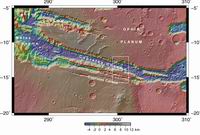 Am 28. Mai 2004 nahm die hochauflösende Stereokamera (HRSC) auf der ESA-Sonde
Mars Express im Orbit 449 einen Teil der Region Coprates Chasma und Coprates
Catena mit einer Auflösung von etwa 48 Metern pro Bildpunkt auf. Die Aufnahmen
zeigen einen Ausschnitt bei 13,5° südlicher Breite und 300° östlicher Länge.
Am 28. Mai 2004 nahm die hochauflösende Stereokamera (HRSC) auf der ESA-Sonde
Mars Express im Orbit 449 einen Teil der Region Coprates Chasma und Coprates
Catena mit einer Auflösung von etwa 48 Metern pro Bildpunkt auf. Die Aufnahmen
zeigen einen Ausschnitt bei 13,5° südlicher Breite und 300° östlicher Länge.
On 28 May 2004 the High-Resolution Stereo Camera (HRSC) onboard the ESA
spacecraft Mars Express obtained image data in orbit 449 with a ground
resolution of approximately 48 metres per pixel. The data were acquired in the
region of Coprates Chasma and Coprates Catena, at approximately 13.5° southern
latitude and 300° eastern longitude.
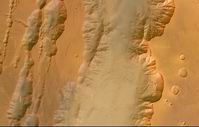 Coprates Chasma ist ein sich über weite Bereiche erstreckender Abschnitt des
zentralen Valles Marineris Canyonsytems. Die im Norden der Farbaufnahme zu
sehenden 8 bis 9 km tiefen Valles Marineris besitzen eine Breite von ungefähr 60
bis 100 km, und trennen die Ebenen Ophir Planum und Thaumasia Planum. Parallel
zum Coprates Chasma sind im südlichen Teil der Aufnahme die Coprates Catena,
mehrere parallel verlaufende bis zu 5 km tiefe Gräben mit einer Breite von bis
zu 22 km zu sehen.
Coprates Chasma ist ein sich über weite Bereiche erstreckender Abschnitt des
zentralen Valles Marineris Canyonsytems. Die im Norden der Farbaufnahme zu
sehenden 8 bis 9 km tiefen Valles Marineris besitzen eine Breite von ungefähr 60
bis 100 km, und trennen die Ebenen Ophir Planum und Thaumasia Planum. Parallel
zum Coprates Chasma sind im südlichen Teil der Aufnahme die Coprates Catena,
mehrere parallel verlaufende bis zu 5 km tiefe Gräben mit einer Breite von bis
zu 22 km zu sehen.
Coprates Chasma is a major trough located roughly in the centre of the Valles
Marineris canyon system. This trough, appearing in the north of the color image,
ranges from approximately 60 km to 100 km wide and extends 8 km to 9 km below
the surrounding plains. Coprates Catena lies parallel to Coprates Chasma and can
be seen in the south of the image as three troughs, ranging from a few
kilometres to 22 km wide and up to 5 km deep.
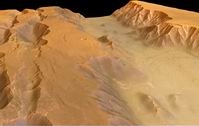 Wie man an der fächerartigen, vermutlich durch einen enormen Erdrutsch zustande
gekommenen 22 km breiten Schuttansammlung am Boden unterhalb der Nordwand von
Candor Chasma erkennen kann, sind die Gräben durch Erosion verändert worden. Der
im Graben liegende atmosphärische Dunst lässt tiefer gelegene Bereiche nur
undeutlich erkennen. Die in der abgebildeten Region markanten linearen
Strukturen, die meist parallel zu den Hauptgräben verlaufen, sind vermutlich
tektonischen Ursprungs.
Wie man an der fächerartigen, vermutlich durch einen enormen Erdrutsch zustande
gekommenen 22 km breiten Schuttansammlung am Boden unterhalb der Nordwand von
Candor Chasma erkennen kann, sind die Gräben durch Erosion verändert worden. Der
im Graben liegende atmosphärische Dunst lässt tiefer gelegene Bereiche nur
undeutlich erkennen. Die in der abgebildeten Region markanten linearen
Strukturen, die meist parallel zu den Hauptgräben verlaufen, sind vermutlich
tektonischen Ursprungs.
These troughs have been modified by erosion, as indicated by the linear features
extending from the upper edge of the trough walls. In contrast to the relatively
sharp appearance of the upper regions of the trough walls, the lower slopes and
the floors of the troughs have a softer appearance, which is probably the result
of atmospheric dust. Linear features, prevalent throughout the image and
trending parallel to the major troughs, may be faults.
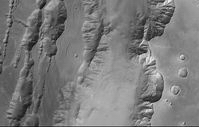 Über den Ursprung des Valles Marineris Canyonsystems besteht noch immer
Unklarheit. Eine Theorie besagt, daß die Bildung der Tharsisaufwölbung - sie
befindet sich westlich des Canyonsystems - Spannung erzeugte und ein Aufbrechen
der Marskruste bewirkte. Eine andere Theorie ist, dass Wasser oder geschmolzenes
Eis Gesteinsmaterial aus dem Untergrund entfernt haben könnte, was ein
Einbrechen der Oberfläche zur Folge hatte. Möglicherweise haben beide Prozesse
zusammengewirkt.
Über den Ursprung des Valles Marineris Canyonsystems besteht noch immer
Unklarheit. Eine Theorie besagt, daß die Bildung der Tharsisaufwölbung - sie
befindet sich westlich des Canyonsystems - Spannung erzeugte und ein Aufbrechen
der Marskruste bewirkte. Eine andere Theorie ist, dass Wasser oder geschmolzenes
Eis Gesteinsmaterial aus dem Untergrund entfernt haben könnte, was ein
Einbrechen der Oberfläche zur Folge hatte. Möglicherweise haben beide Prozesse
zusammengewirkt.
Scientists are unsure of the mechanism responsible for the creation of the
Valles Marineris canyon system. Some suggest that the formation of the Tharsis
Rise, located west of the canyon system, caused tension and fracturing of the
Martian crust. Other researchers believe that water may have removed rock
material from the subsurface, which caused the surface to collapse. A somewhat
related theory suggests that large quantities of subsurface ice melted, causing
surface collapse. Possibly all of these processes together were active in
forming the structure.
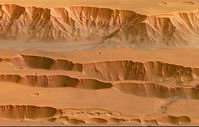 Das Canyonsystem der Valles Marineris erlaubt der Wissenschaft einen Blick in
die tieferen Schichten des Mars und ermöglicht es, die komplexe geologische und
klimatische Geschichte des roten Planeten zu erforschen. Indem die HRSC-Kamera
den Wissenschaftlern neue Daten in hoher Auflösung über grössere Gebiete sowie
in Farbe und 3D liefert, trägt sie wesentlich zu unserem wachsenden Verständnis
des roten Planeten bei.
Das Canyonsystem der Valles Marineris erlaubt der Wissenschaft einen Blick in
die tieferen Schichten des Mars und ermöglicht es, die komplexe geologische und
klimatische Geschichte des roten Planeten zu erforschen. Indem die HRSC-Kamera
den Wissenschaftlern neue Daten in hoher Auflösung über grössere Gebiete sowie
in Farbe und 3D liefert, trägt sie wesentlich zu unserem wachsenden Verständnis
des roten Planeten bei.
Valles Marineris provides scientists with a window into the depths of Mars and
enables them to study the complex geologic and climatic history of the red
planet. By supplying new data for Valles Marineris, including colour and stereo
images, the HRSC camera aids scientists in this endeavour, ultimately improving
our understanding of this fascinating planet.
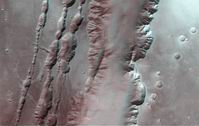 Die Farbansichten wurden aus dem senkrecht blickenden Nadirkanal und den Farbkanälen erstellt, die Schrägansicht wurde aus den Stereokanälen der HRSC berechnet. Die Anaglyphen werden aus dem Nadirkanal und einem Stereokanal abgeleitet. Die schwarzweißen Detailaufnahmen wurden dem Nadirkanal entnommen, der von allen Kanälen die höchste Auflösung zur Verfügung stellt.
Die Farbansichten wurden aus dem senkrecht blickenden Nadirkanal und den Farbkanälen erstellt, die Schrägansicht wurde aus den Stereokanälen der HRSC berechnet. Die Anaglyphen werden aus dem Nadirkanal und einem Stereokanal abgeleitet. Die schwarzweißen Detailaufnahmen wurden dem Nadirkanal entnommen, der von allen Kanälen die höchste Auflösung zur Verfügung stellt.
The colour scenes have been derived from the three HRSC-colour channels and the nadir channel. The perspective views have been calculated from the digital terrain model derived from the stereo channels. The anaglyph image was calculated from the nadir and one stereo channel. The black and white high resolution images were derived form the nadir channel which provides the highest detail of all channels.
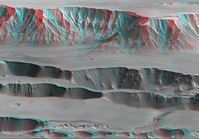 Das Kameraexperiment HRSC auf der Mission Mars Express der
Europäischen Weltraumorganisation ESA wird vom Principal Investigator Prof. Dr.
Gerhard Neukum (Freie Universität Berlin), der auch die technische Konzeption der
hochauflösenden Stereokamera entworfen hatte, geleitet. Das
Wissenschaftsteam besteht aus 40 Co-Investigatoren aus 33 Institutionen und zehn
Nationen. Die Kamera wurde am Deutschen Zentrum für Luft- und Raumfahrt (DLR) unter der
Leitung des Principal Investigators (PI) G. Neukum entwickelt und in Kooperation mit
industriellen Partnern gebaut (EADS Astrium, Lewicki Microelectronic GmbH und Jena
-Optronik GmbH). Sie wird vom DLR -Institut für Planetenforschung in Berlin-Adlershof
betrieben. Die systematische Prozessierung der Daten erfolgt am DLR. Die Darstellungen
wurden vom Institut für Geologische Wissenschaften der FU Berlin in Zusammenarbeit
mit dem DLR-Institut für Planetenforschung erstellt.
Das Kameraexperiment HRSC auf der Mission Mars Express der
Europäischen Weltraumorganisation ESA wird vom Principal Investigator Prof. Dr.
Gerhard Neukum (Freie Universität Berlin), der auch die technische Konzeption der
hochauflösenden Stereokamera entworfen hatte, geleitet. Das
Wissenschaftsteam besteht aus 40 Co-Investigatoren aus 33 Institutionen und zehn
Nationen. Die Kamera wurde am Deutschen Zentrum für Luft- und Raumfahrt (DLR) unter der
Leitung des Principal Investigators (PI) G. Neukum entwickelt und in Kooperation mit
industriellen Partnern gebaut (EADS Astrium, Lewicki Microelectronic GmbH und Jena
-Optronik GmbH). Sie wird vom DLR -Institut für Planetenforschung in Berlin-Adlershof
betrieben. Die systematische Prozessierung der Daten erfolgt am DLR. Die Darstellungen
wurden vom Institut für Geologische Wissenschaften der FU Berlin in Zusammenarbeit
mit dem DLR-Institut für Planetenforschung erstellt.
The High Resolution Stereo Camera (HRSC) experiment on the ESA Mars Express Mission is led by the Principal Investigator (PI) Prof. Dr. Gerhard Neukum who also designed the camera technically. The science team of the experiment consists of 40 Co-Investigators from 33 institutions and 10 nations. The camera was developed at the German Aerospace Center (DLR) under the leadership of the PI G. Neukum and built in cooperation with industrial partners (EADS Astrium, Lewicki Microelectronic GmbH and Jena-Optronik GmbH). The experiment on Mars Express is operated by the DLR Institute of Planetary Research, through ESA/ESOC. The systematic processing of the HRSC image data is carried out at DLR. The scenes shown here were created by the PI-group at the Institute for Geological Sciences of the Freie Universitaet Berlin in cooperation with the German Aerospace Center (DLR), Institute of Planetary Research, Berlin.
Download
hochaufgelöste Bilddaten / full resolution image data
| Kontextkarte (MOLA) / Context Map (MOLA) | download TIF ( 8.2 MBs ) |
| Nadiraufnahme / Grayscale Nadir Image | download TIF ( 15.6 MBs ) |
| RGB Farbbild / RGB Colour Image | download TIF ( 46.9 MBs ) |
| Rot-Cyan Anaglyphe #1 / Red-cyan anaglyphe #1 | download TIF ( 46.9 MBs ) |
| Rot-Cyan Anaglyphe #2 / Red-cyan anaglyphe #2 | download TIF ( 15.5 MBs ) |
| Perspektive / Perspective view | download TIF ( 44.7 MBs ) |
| Perspektive #2 / Perspective view #2 | download TIF ( 44.7 MBs ) |

 Deutsch
Deutsch

